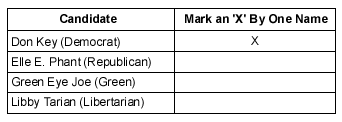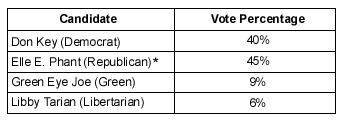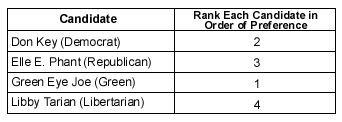RAI Testimony
Testimony of Thomas Andrew Bryer
Executive Director, Reform America, Inc.
Maryland Senate
Committee on Economic and Environmental Affairs
SB 233
Elections - Instant Runoff Method of Voting
February 15, 2001 - 1:00pm
My name is Thomas Bryer. I am the Project Leader for government performance projects, Council for Excellence in Government. In that role I seek to improve the inner-workings of government - management practices and the rest - to better serve the public. What brings me here today is my role as Executive Director of Reform America, Inc.
Reform America is a national not-for-profit organization based in Bethesda, Maryland. Our objective is to develop leadership skills of young Americans while engaging them and their peers in the political and voting processes, as well as in the movement to reform some of our democratic institutions. With such programs as our High School Motivators, Campus Coordinators, and Women's Empowerment Initiative, Reform America remains true to four basic tenets:
1. Every voter should have a fair and equal say in the political process;
2. Every vote should have equal weight in the electoral process;
3. Voters should have unhindered choice of and unguarded access to political thought and opinion;
4. Voter turnout must be increased, particularly among young people, to ensure the legitimacy and viability of our political system.
Reform America feels that in order to increase voter participation among young people, we need to follow a certain path of reform and innovation:
![]() Educate young people about the United States political system, government, and its history in high school and earlier using interactive and hands-on techniques;
Educate young people about the United States political system, government, and its history in high school and earlier using interactive and hands-on techniques;
![]() Engage young people in a grass roots effort for change and improvement in US voting systems, ballot access restrictions, and candidate debate regulations;
Engage young people in a grass roots effort for change and improvement in US voting systems, ballot access restrictions, and candidate debate regulations;
![]() Make the individual vote worth something through electoral reform (don't simply "convince" young people that the individual vote is worth something);
Make the individual vote worth something through electoral reform (don't simply "convince" young people that the individual vote is worth something);
![]() Experiment with new technologies for voting on college campuses, coupled with the experimentation of alternative voting methods;
Experiment with new technologies for voting on college campuses, coupled with the experimentation of alternative voting methods;
![]() Open candidate debates to include alternative political party candidates and independents;
Open candidate debates to include alternative political party candidates and independents;
![]() Open the ballot to give voters fair and equal choice.
Open the ballot to give voters fair and equal choice.
These tenets and action items have attracted widespread support of young people throughout Maryland and around the country. Based on our lessons learned from young Americans in all our activities and on the above principles this testimony will be based around two themes:
1. Every vote not only has to be counted; every vote has to count.
2. Voters need to be treated like the stakeholders they are. Voters need to both feel like they have a stake in the system, and they have to actually have a stake in the system.
Every vote has to be counted …
After the much-publicized troubles with ballots in election 2000 and the increasing number of claims and documented incidents of uncounted ballots, legislatures around the country are racing to convene task forces and special committees to study the problem and recommend changes to ensure every vote is counted in future elections. State governments, as well as Congress, are promising to invest sums of money to modernize voting machines and ballot-types to ensure that every voter that casts a ballot can leave the polling station with the knowledge and peace of mind that her or his vote will be counted.
These are all great initiatives that deserve our full support. We can ill afford to stop there, though.
…Every vote has to count.
The bill before the committee today offers a voting method that will ensure every vote is not only counted but that every vote will count.
Instant Runoff Voting (IRV) enables the voter to express his/her preference on the ballot by rank-ordering the candidates (1, 2, 3, etc). In order to win, a candidate needs to earn at least 50% of the vote (just like in a second-ballot runoff election where the two top candidates in a first-round election square off in a second-round election). Voters can express their views all on one ballot, instead of going to the polls twice, and voters do not have to worry about strategically voting to avoid wasting their vote no vote can be wasted using IRV.
When you go to the polls today to fill a single-seat/single-winner office, you mark a single 'X' or punch a single hole next to a single name. The winner is the candidate that gets the greatest number of votes (in a ten person race to fill one seat, that could mean the winner is elected with as little as 10% of the vote!).
The image below is a reproduction of the ballot-form used today throughout Maryland for the first-past-the-post (FPTP) voting method, followed by a final FPTP tally.


*Winner
Under IRV, instead of marking an 'X' next to just one name, you would rank-order the candidates (1, 2, 3, etc.) for as long as you have a preference of one candidate over another on the ballot. If a candidate does not earn 50% or more after the first vote count, the candidate that finished last is eliminated, and all voters that selected that candidate as their first choice will have their votes transferred to their second choice candidate. This process continues until one candidate reaches the 50% mark.
The image below is the likeness of what an IRV ballot would like, followed by an image demonstrating the IRV vote-tallying process.


*Winner
As you can see in this example, and as often happens in reality, the Green party candidate acted like a spoiler under FPTP, taking votes away from the Democrat, helping the Republican win. Under IRV, after two vote transfers, the peoples' true preferences were evident, and the Democrat won with more than 50% support. After the first count the Libertarian had the least number of votes and was eliminated. Her 6% was transferred, based on voters expressed preferences, with 1% going to Green, 3% to Republican, and 2% to Democrat. After that transfer, the Green candidate was left with the least number of votes, so his 10% was transferred, based on voters expressed preferences. The 1% that went from Libertarian to Green seemed to give their third choice to Republican, and the 9% of original Green first-choice supporters gave their support to the Democrat. No vote was wasted; no candidate was a spoiler; no voter had to vote strategically every vote counted!
IRV in Reality; Voters as Stakeholders
SB 233 proposes a voting method that empowers the individual voter and makes election outcomes much more representative of the desires of the voting population for single-seat races. IRV eliminates the wasted vote and the feeling among voters that they should vote strategically, forced to choose between what many consider the "lesser of two evils", in order to prevent the least preferred candidate from winning. The Nader factor in the 2000 presidential election and arguably the Perot factor in the 1992 presidential election vividly paint the picture of voters torn between a preferred candidate that "stands no chance of winning" and a less preferred candidate that "is better than the other guy".
Some voters acknowledge the possibility of a spoiler effect but stand on principle or throw chance into the wind and vote for their most preferred candidate for office. It can be argued that if IRV were used in the state of Florida in the 2000 presidential election Al Gore would be our President right now.
Here in Maryland, a State that is, as evidenced by the membership of this committee, strongly Democratic, supporters of Ralph Nader did not fear as much as in other states throwing the election to George W. Bush by voting for the Green Party candidate. State Board of Election numbers show 53,768 Maryland voters cast their ballot for Ralph Nader. 10,476 Maryland voters cast their ballots for some other non-write-in alternative party candidate. I include myself in this number; I did not fear, since Maryland is such a strong Democratic state, that my vote would throw the election one way or another. I acknowledged, however dishearteningly, that by taking my one vote and casting it for my most preferred candidate - a third party candidate - I was effectively tossing my vote into a black hole, where it would be sucked into a land of "wasted" votes. This land, known now by 64,244+ Maryland voters, is filled with ballots that were counted but which carried votes that did not count.
This does not inspire continued or increased poll attendance on Election Day.
Conclusion
Third parties are growing in Maryland. Membership is up, and third party candidacies are increasing. Outreach efforts are expanding at what are at-times a dizzying pace. As the number of parties increases, and as voters are given the opportunity to choose between more than two viable candidates for all levels of office in Maryland, the method of voting inherits a much higher level of importance.
Take the opportunity before you to endorse and actively support SB 233. Make Maryland a leader in the advancement of this voting method whose time has come and whose time for implementation is fast approaching throughout the United States. Do not force voters to vote strategically. Empower the voter. Increase the legitimacy of your leadership in the eyes of the voter. Make every vote count.
![]()
Reform America, Inc.
Phone:
